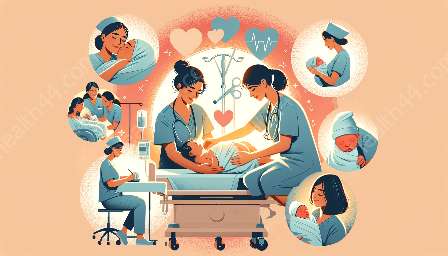Dive into the awe-inspiring world of anatomy and physiology as it pertains to maternal and newborn nursing. From the physiological changes during pregnancy to the intricate mechanisms of childbirth and the tender nuances of neonatal care, this comprehensive topic cluster explores the intricacies of the human body in the context of maternal and newborn nursing.
Physiological Changes During Pregnancy
During pregnancy, a woman's body undergoes remarkable physiological changes to support the growing fetus. The anatomical adaptations include the expansion of the uterus, changes in the cardiovascular system, and alterations in hormonal levels. Understanding these changes is crucial for providing optimal care and support to expectant mothers.
Childbirth: A Symphony of Physiology
The act of childbirth is an intricate dance of physiological processes involving the mother and the newborn. From the onset of labor to the delivery of the baby, the body's physiology orchestrates a symphony of contractions, cervical dilation, and the expulsion of the placenta. Delve into the physiology of childbirth, including the stages of labor and the physiological responses of both the mother and the newborn.
Neonatal Physiology
Upon birth, newborns face a transition from the intrauterine environment to the outside world. This transition involves complex physiological adjustments, such as the circulation of blood through the lungs, the establishment of respiratory patterns, and the initiation of breastfeeding. Understanding the neonatal physiology is essential for providing competent and compassionate care to newborns and assisting them in their critical first moments of life.
Anatomy and Physiology in Maternal and Newborn Nursing Practice
Application of knowledge in anatomy and physiology is paramount in the practice of maternal and newborn nursing. From assessing fetal well-being through techniques such as auscultation of fetal heart tones to understanding the physiological basis of common complications in pregnancy and childbirth, nurses specializing in maternal and newborn care rely on a profound understanding of anatomical and physiological principles to guide their practice.
Educating and Empowering Mothers
Equipped with insights into the anatomy and physiology of pregnancy, childbirth, and postpartum care, nurses are well-positioned to educate and empower expectant mothers. By explaining the physiological changes occurring in their bodies and elucidating the remarkable processes of childbirth, nurses play a pivotal role in preparing mothers for the journey of childbirth and motherhood.
Embracing the Wonders of New Life
The study of anatomy and physiology in maternal and newborn nursing allows nurses to embrace the wonders of new life with a deep understanding of the remarkable physiological transformations occurring in the mother and the newborn. This understanding fosters a sense of awe and reverence for the intricacies of the human body and the miracles of childbirth and new life.
Conclusion
In the realm of maternal and newborn nursing, a profound understanding of anatomy and physiology serves as the cornerstone of competent and compassionate care. By delving into the physiological changes during pregnancy, the intricacies of childbirth, and the marvels of neonatal physiology, nurses are equipped to provide exceptional care to expectant mothers and their newborns, ushering them into the miraculous journey of childbirth and early parenthood.


